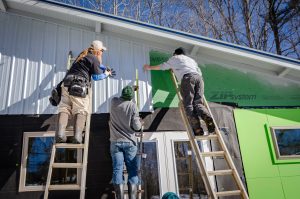If you’ve been watching the real estate sector in Texas, then you know Texas has plenty of land on which to build. That’s according to Sharestates’ Texas Regional Sales Director Paul Cinciripini.
Based in Houston, one of the hottest real estate markets in the country, Cinciripini is very familiar with Lone Star State’s real estate market. Dallas, Austin, San Antonio, and Houston are routinely mentioned as top markets in the nation. PwC puts both Dallas and Austin among the top 10 U.S. real estate markets for 2022. For building new homes, both cities are in the top five.
“Houston and Dallas are two of the largest real estate markets in the country,” Cinciripini said. “Right now, they’re on the proverbial fire.”
Unlike other markets in the nation where skyrocketing prices are driving the golf cart, in Texas, it’s demand. Texas is one of the hottest places for people relocating from New York and California. Companies in the energy and technology sectors like Texas for its low tax rates. Large companies relocating to the state drive more demand for housing in a climate that’s already known for its low inventory.
Like PwC, Zillow ranks Austin in the top 10 markets for 2022. Carmaker Tesla relocated from Silicon Valley to Austin last year and expects about half of its 10,000 Palo Alto employees to move with it.
National Mortgage News lists Austin as the fourth hottest real estate market in 2022 and Dallas-Fort Worth as the seventh. It seems like a national consensus then. Texas is hot for real estate.
 Real Estate in Texas is Still Affordable
Real Estate in Texas is Still Affordable
Unlike real estate values in many other parts of the country, Texas real estate is still affordable because prices aren’t rising as fast. It’s easy to find deals that don’t have a $1 million entrance fee.
Texas is the second-most populous state in the country. And it’s spread out. Houses aren’t built right on top of each other and there’s still a lot of land. That means builders are building in larger cities like Dallas and Houston.
“When you have a large number of people consolidated in one area,” Cinciripini said, “you typically have more buying options. But now you have fewer options because of the population growth and low inventory. And we see a lot of bidding wars.”
Investors and homebuyers are getting creative with their buying strategies. People are buying off-market and paying more than they would in a normal situation.
Another thing impacting the real estate market is cash purchasing. Wealthy investors can pull it out of their pockets, but others can leverage private capital to make themselves more competitive. When it’s time to pull the trigger and buy a property, they’ve got the cash available and can close the deal faster.
Because the market is on fire, investors have flexibility in the types of deals they can buy into. Dallas and Houston have fix-and-flip opportunities in a lot of the older neighborhoods. Those are easy to find. And since the cost of living is lower than in other places around the country, investors are getting good deals, paying lower prices, and closing deals faster.
Fix-and-flips are bountiful in other Texas markets too. Gentrification of older neighborhoods keeps the real estate cycle moving. Sellers win because they get more for their properties and buyers win because they can close quickly and have built-in exit strategies.
 Single-Family Rentals Are Selling by the Dozen
Single-Family Rentals Are Selling by the Dozen
In terms of single-family residential rentals, Texans have figured out how to sell them in multiple units.
Developers shifted their focus during the pandemic. Because remote work has become the preferred employment status for many workers, people don’t have to live in the city. That widened the development area for many ground-up construction companies. They’re building entire housing communities and selling them to large investors as complete portfolios of rental homes. That allows the builders to streamline their processes, control their costs more effectively, build more efficiently, and be more profitable. Plus, it reduces stress in the construction and selling process because they’re dealing with only one buyer rather than hundreds.
“A part of it is control,” Cinciripini said,” and partly it’s opportunity.”
There’s less risk for investment firms and they’re willing to spend more on the properties. By purchasing in volume, they control more of the factors.
One unique aspect of Texas real estate is how industry insiders define a metro area. People coming from other parts of the country may look at Dallas or Houston and see the outlying communities as separate cities. In some cases, rural land can exist between two of the exurbs, but Texans see that as a part of the metroplex. For instance, bedroom communities north of Dallas—Plano, Allen, McKinney, etc.—are considered a part of the DFW Metroplex making the wider Metro area larger than it appears.
What that means for builders is that they can market their properties built in these cities and neighborhoods as a part of the DFW Metroplex rather than some small town outside of the city. That’s a big benefit to people moving to Texas from other locations where things are closer together.
It all boils down to demand. Homebuyers, because of an uptick in remote work opportunities, prefer living outside of the city. Fewer people are commuting and that’s creating opportunities in rural areas and smaller towns.
Pent-Up Demand Means Low Inventory Is Still Driving the Market
What happened during the pandemic is that construction slowed down. Social distancing guidelines had construction virtually come to a halt.
“That giant e-brake coke-bottled everything,” Cinciripini said. “Now, there’s pent-up demand and builders can’t get single-family developments up fast enough.”
While Cinciripini sees a slowdown ahead, some type of market correction, he doesn’t think the market will crash. There’s just too much demand. The Fed’s interest rate hikes may cause a slowdown in price increases and slow down borrowing, but development is still going to take place to meet the demand for homes. This will be especially true if people keep moving to Texas at the same pace as in the last year.
“Texas used to be a get-rich slow state,” Cinciripini said. “Appreciation was about 1 percent year over year on real estate. Now, it’s about a 5 percent to 10 percent return every year on property values. Sometimes, it’s more.”
For that reason, he thinks it will be a long time before the market gets back to “normal” conditions, an equilibrium in buying and selling, supply and demand. In the state’s Golden Triangle area—typically defined as the area between Beaumont, Port Arthur, and Orange in the southeast part of the state—real estate values are rising fast. They’re also going up in Austin, San Antonio, and other markets smaller than Dallas and Houston. Where the population is growing, that’s where appreciation is seen the most.
Don’t Think Too Hard: Get In, Get Out, Make Your Money
Cinciripini says investors looking to get in on the latest and hottest deal should act fast. “Don’t think too hard,” he said. “If a deal makes sense, act on it quickly.”
The reason is very simple. There’s a lot of competition in Texas real estate investing. If you don’t act quickly, someone else will swoop in and make a deal right out from under you. Sellers are getting multiple offers a day and some of them are cash offers, money in hand. If you look at a house today, the investor who looked at it yesterday has the money ready to transfer. If the numbers line up, pull the trigger.
The average number of days on the market in Texas is under 20 days. If it’s a good location and a good price, it’s even less. The good news for investors is this: Whether you’re looking for a fix-and-flip opportunity, single-family rentals, or ground-up construction deals, there’s plenty to go around. Texas is a real estate investing paradise.
For more information, call Paul Cinciripini.



